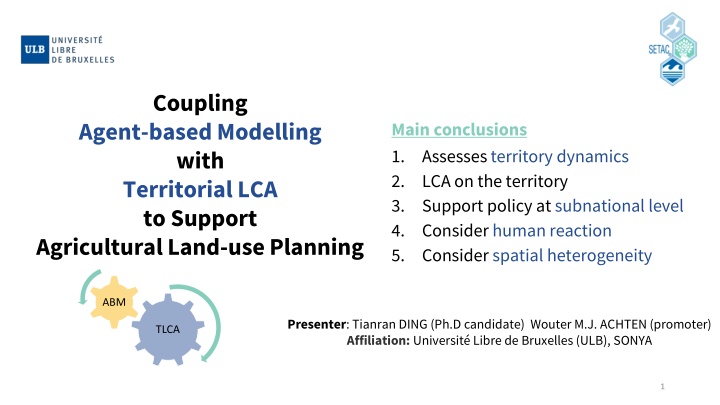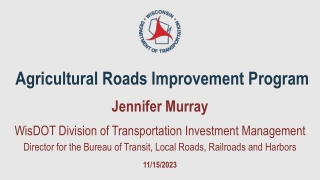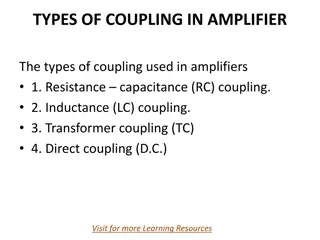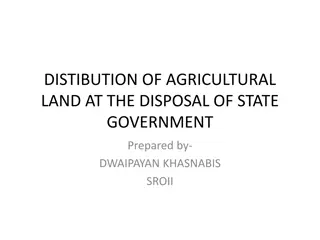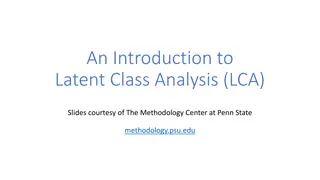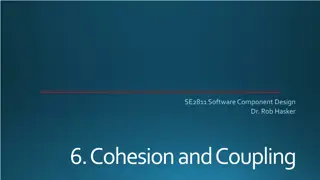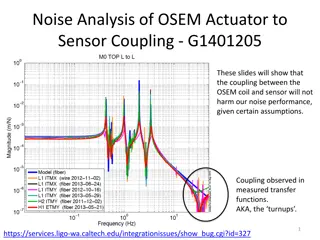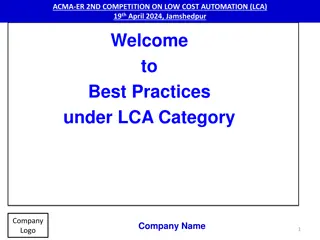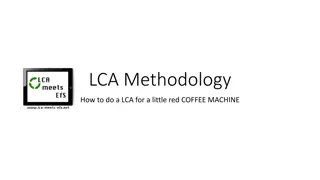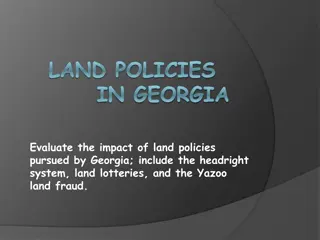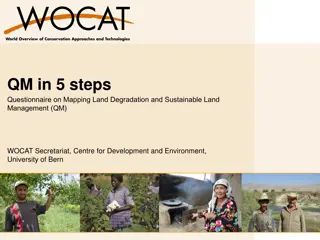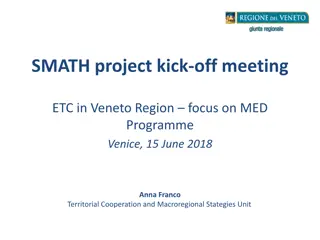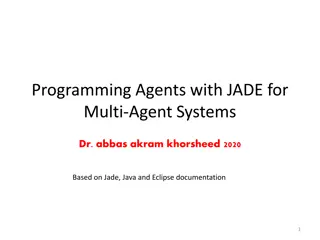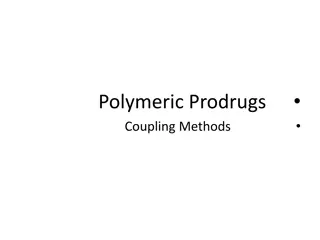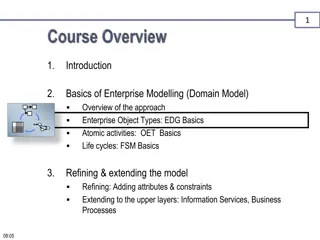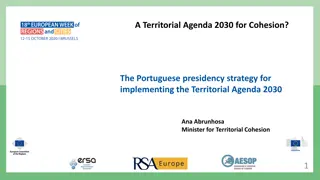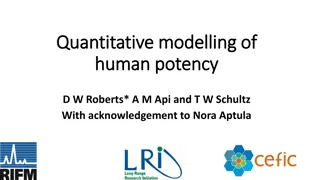Coupling Agent-based Modelling with Territorial LCA for Agricultural Land-use Planning
This study focuses on coupling agent-based modelling with Territorial LCA to support agricultural land-use planning. It assesses territory dynamics, considers human reactions, and supports policy at the subnational level. The research aims to understand the impacts of policy interventions on territory dynamics and environmental efficiency in land use planning scenarios.
Download Presentation

Please find below an Image/Link to download the presentation.
The content on the website is provided AS IS for your information and personal use only. It may not be sold, licensed, or shared on other websites without obtaining consent from the author.If you encounter any issues during the download, it is possible that the publisher has removed the file from their server.
You are allowed to download the files provided on this website for personal or commercial use, subject to the condition that they are used lawfully. All files are the property of their respective owners.
The content on the website is provided AS IS for your information and personal use only. It may not be sold, licensed, or shared on other websites without obtaining consent from the author.
E N D
Presentation Transcript
Coupling Agent-based Modelling with Territorial LCA to Support Agricultural Land-use Planning Main conclusions 1. Assesses territory dynamics 2. LCA on the territory 3. Support policy at subnational level 4. Consider human reaction 5. Consider spatial heterogeneity ABM Presenter: Tianran DING (Ph.D candidate) Wouter M.J. ACHTEN (promoter) Affiliation: Universit Libre de Bruxelles (ULB), SONYA TLCA 1
Threat to biodiversity and ecosystem services Need to use land wisely, need for agricultural land planning Increasing demand for bio- based products Increasing demand for food Limited land available 2010 2100 61% calorie requirements due to population growth (Depenbusch & Klasen2019) 61% 60% 60% from biomass (EU, 2019) 50% habitable land is already occupied for agriculture 2019) 50% of increase on of earth renewable energy should 2
Policy influences human decisions, human decisions influence territory dynamic In agricultural sector, it is farmer who decide how to use their farm-land. Policy can only influence their choices, mainly via subsidies, taxes and regulations Municipality of Plombi re 3
AIM: Dynamic Territorial LCA (DTLCA) to assess impacts of policy intervention, consider human factor Territory eco - - Territory eco- -efficiency Land use function Environmental impacts efficiency Land planning scenario Land planning scenario (Loiseau et al. 2013) Territorial LCA 4
AIM: Dynamic Territorial LCA (DTLCA) to assess policy intervention on territory dynamics Policy Policy Territory eco - - Territory eco- -efficiency Land use function Environmental impacts efficiency e.g., provide subsidies on biomass-for-energy Simulated land use scenarios Simulated land use scenarios (Loiseau et al. 2013) Territorial LCA ABM 5
DTLCA framework (provide subsidy for adopting land use 3 or 4) Spatially explicit score of each unit of option Land use types: 1, 2, 3, 4 ?0 Caltivate 3 Caltivate 4 1 1 1 1 ?1 1-3 1-3 1-3 1-3 1-4 1-4 1-4 1-4 Option score (spatial) Link agents 1 1 3 1 1-3 1-3 3 1-3 1-4 1-4 3 1-4 2 2 4 2 2-3 2-3 4 2-3 2-4 2-4 4 2-4 2 2 2 2 ?? 2-3 2-3 2-3 2-3 2-4 2-4 2-4 2-4 e.g. 1-3: if conversing crop 1 to 3 Agents If agents consider environmental impacts in decisions Characteristics (internal factors, e.g., farmer age) Spatially dynamic Spatially dynamic Temporally dynamic Temporally dynamic 1 3 3 3 Y Dynamic Dynamic Environmental impacts 2 3 3 3 ABM TLCA ?? Dynamic Dynamic Land use functions 2 4 4 4 2 4 4 4 NY ?? Y: Yong NY: Not young Policy 6
DTLCA framework (provide subsidy for adopting land use 3 or 4) Spatially explicit score of each unit of option Land use types: 1, 2, 3, 4 ?0 Caltivate 3 Caltivate 4 1 1 1 1 ?1 1-3 1-3 1-3 1-3 1-4 1-4 1-4 1-4 Option score (spatial) Link agents 1 1 3 1 1-3 1-3 3 1-3 1-4 1-4 3 1-4 2 2 4 2 2-3 2-3 4 2-3 2-4 2-4 4 2-4 2 2 2 2 ?? 2-3 2-3 2-3 2-3 2-4 2-4 2-4 2-4 e.g. 1-3: if conversing crop 1 to 3 Agents If agents consider environmental impacts in decisions Characteristics (internal factors, e.g., farmer age) Spatially dynamic Spatially dynamic Temporally dynamic Temporally dynamic 1 3 3 3 Y Dynamic Dynamic Environmental impacts 2 3 3 3 ABM TLCA ?? Dynamic Dynamic Land use functions 2 4 4 4 2 4 4 4 NY ?? Y: Yong NY: Not young Policy 7
DTLCA framework (provide subsidy for adopting land use 3 or 4) Spatially explicit score of each unit of option Land use types: 1, 2, 3, 4 ?0 Caltivate 3 Caltivate 4 1 1 1 1 ?1 1-3 1-3 1-3 1-3 1-4 1-4 1-4 1-4 Option score (spatial) Link agents 1 1 3 1 1-3 1-3 3 1-3 1-4 1-4 3 1-4 2 2 4 2 2-3 2-3 4 2-3 2-4 2-4 4 2-4 2 2 2 2 ?? 2-3 2-3 2-3 2-3 2-4 2-4 2-4 2-4 e.g. 1-3: if conversing crop 1 to 3 Agents If agents consider environmental impacts in decisions Characteristics (internal factors, e.g., farmer age) Spatially dynamic Spatially dynamic Temporally dynamic Temporally dynamic 1 3 3 3 Y Dynamic Dynamic Environmental impacts 2 3 3 3 ABM TLCA ?? Dynamic Dynamic Land use functions 2 4 4 4 2 4 4 4 NY ?? Y: Yong NY: Not young Policy 8
DTLCA framework (provide subsidy for adopting land use 3 or 4) Spatially explicit score of each unit of option Land use types: 1, 2, 3, 4 ?0 Caltivate 3 Caltivate 4 1 1 1 1 ?1 1-3 1-3 1-3 1-3 1-4 1-4 1-4 1-4 Option score (spatial) Link agents 1 1 3 1 1-3 1-3 3 1-3 1-4 1-4 3 1-4 2 2 4 2 2-3 2-3 4 2-3 2-4 2-4 4 2-4 2 2 2 2 ?? 2-3 2-3 2-3 2-3 2-4 2-4 2-4 2-4 e.g. 1-3: if conversing crop 1 to 3 Agents If agents consider environmental impacts in decisions Characteristics (internal factors, e.g., farmer age) Spatially dynamic Spatially dynamic Temporally dynamic Temporally dynamic 1 3 3 3 Y Dynamic Dynamic Environmental impacts 2 3 3 3 ABM TLCA ?? Dynamic Dynamic Land use functions 2 4 4 4 2 4 4 4 NY ?? Y: Yong NY: Not young Policy 9
DTLCA framework (provide subsidy for adopting land use 3 or 4) Spatially explicit score of each unit of option Land use types: 1, 2, 3, 4 ?0 Caltivate 3 Caltivate 4 1 1 1 1 ?1 1-3 1-3 1-3 1-3 1-4 1-4 1-4 1-4 Option score (spatial) Link agents 1 1 3 1 1-3 1-3 3 1-3 1-4 1-4 3 1-4 2 2 4 2 2-3 2-3 4 2-3 2-4 2-4 4 2-4 2 2 2 2 ?? 2-3 2-3 2-3 2-3 2-4 2-4 2-4 2-4 e.g. 1-3: if conversing crop 1 to 3 Agents If agents consider environmental impacts in decisions Characteristics (internal factors, e.g., farmer age) Spatially dynamic Spatially dynamic Temporally dynamic Temporally dynamic 1 3 3 3 Y Dynamic Dynamic Environmental impacts 2 3 3 3 ABM TLCA ?? Dynamic Dynamic Land use functions 2 4 4 4 2 4 4 4 NY ?? Y: Yong NY: Not young Policy 10
DTLCA framework (provide subsidy for adopting land use 3 or 4) Spatially explicit score of each unit of option Land use types: 1, 2, 3, 4 ?0 Caltivate 3 Caltivate 4 1 1 1 1 ?1 1-3 1-3 1-3 1-3 1-4 1-4 1-4 1-4 Option score (spatial) Link agents 1 1 3 1 1-3 1-3 3 1-3 1-4 1-4 3 1-4 2 2 4 2 2-3 2-3 4 2-3 2-4 2-4 4 2-4 2 2 2 2 ?? 2-3 2-3 2-3 2-3 2-4 2-4 2-4 2-4 e.g. 1-3: if conversing crop 1 to 3 Agents If agents consider environmental impacts in decisions Characteristics (internal factors, e.g., farmer age) Spatially dynamic Spatially dynamic Temporally dynamic Temporally dynamic 1 3 3 3 Y Dynamic Dynamic Environmental impacts 2 3 3 3 ABM TLCA ?? Dynamic Dynamic Land use functions 2 4 4 4 2 4 4 4 NY ?? Y: Yong NY: Not young Policy 11
DTLCA framework (provide subsidy for adopting land use 3 or 4) Spatially explicit score of each unit of option Land use types: 1, 2, 3, 4 ?0 Caltivate 3 Caltivate 4 1 1 1 1 ?1 1-3 1-3 1-3 1-3 1-4 1-4 1-4 1-4 Option score (spatial) Link agents 1 1 3 1 1-3 1-3 3 1-3 1-4 1-4 3 1-4 2 2 4 2 2-3 2-3 4 2-3 2-4 2-4 4 2-4 2 2 2 2 ?? 2-3 2-3 2-3 2-3 2-4 2-4 2-4 2-4 e.g. 1-3: if conversing crop 1 to 3 Agents If agents consider environmental impacts in decisions Characteristics (internal factors, e.g., farmer age) Spatially dynamic Spatially dynamic Temporally dynamic Temporally dynamic 1 3 3 3 Y Dynamic Dynamic Environmental impacts 2 3 3 3 ABM TLCA ?? Dynamic Dynamic Land use functions 2 4 4 4 2 4 4 4 NY ?? Y: Yong NY: Not young Policy 12
CASE STUDY CASE STUDY 13
LOW CARBON SOCIETY (Cornet et al. 2013) Belgium has committed to reduce greenhouse gas emissions by at least 80% by 2050 relative to 1990. Agricultural sector can make a contribution by: Reducing meat consumption Increasing biomass for energy required increase in bioenergy utilization, imported or indigenous of current meat consumption is for a balanced and healthy diet 47 % 220% 14
Promote bioenergy on current animal land use in Wallonia We select the perrenial crop of miscanthus, and explore its bioenergy conversion through (1) direct combustion (2) anaerobic digestion Conversion Anaerobic digestion Biogas Cultivation Miscanthus Combustion (CHP) Heat Electricity In-territory Off-territory Supportive activities outside the territory, e.g., fertilizer, pesticide, diesel, machine 15
Two measures, Two scenarios, Three influential factors Two measures, Two scenarios, Three influential factors Two measures: (1) Provide subsidies (2) Install demonstration farms Two measures: Two scenarios: (1) Scenario 1 (S1-N), demonstration farms in north, (2) Scenario 2 (S2-S), demonstration farms in south Two scenarios: Any farmer who adopt miscanthus will receive 60 /ha extra subsidies Demonstration farms for AD- miscanthus in S1-N Three factors: (1) Farm size (2) Familiarity (distance to adopters) (3) Revenue (including subsidy) Three factors: Demonstration farms for AD- miscanthus in S2-S 16
KEY RESULTS Freshwater acidification Climate change water availability, freshwater ecosystem 1. 1. Promote bioenergy could reduce impacts Promote bioenergy could reduce environmental impacts environmental 2. 2. Install demonstration farm in north and south will lead to different reduction rate Install demonstration farm in north and south will lead to different reduction rate Freshwater eutrophication Freshwater eutrophication formation Particulate matter Ozone layer depletion 1. 1. Farmer heterogeneity 2. 2. Spatial heterogeneity Farmer heterogeneity Spatial heterogeneity 17
Main conclusions 1. Assesses territory dynamics 2. LCA on the territory 3. Support policy at subnational level 4. Consider human reaction 5. Consider spatial heterogeneity Outlooks 1. Agent data more detailed 2. Link with economic models 3. Apply on different sectors 18
Thank you for your attention! Contact tianran.ding@ulb.be 19
